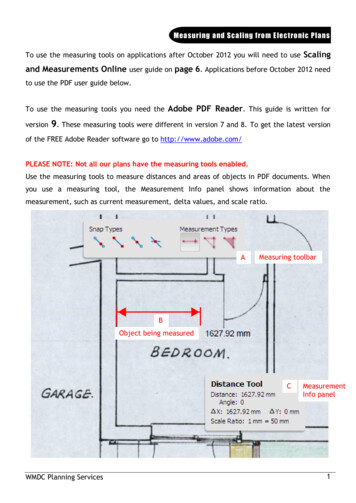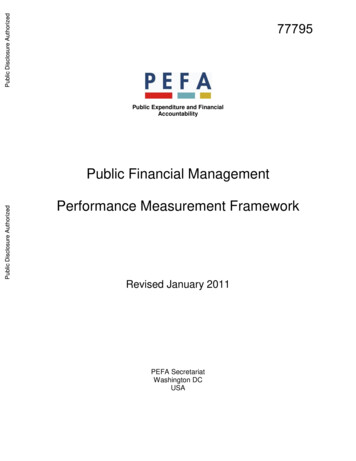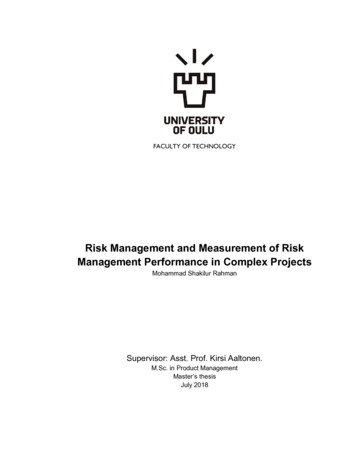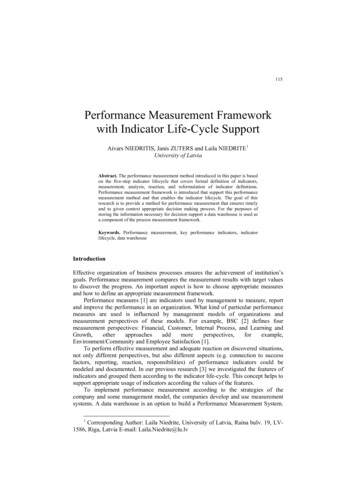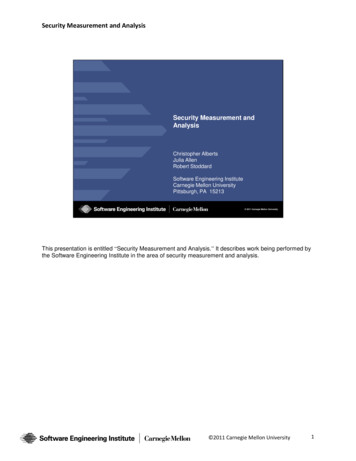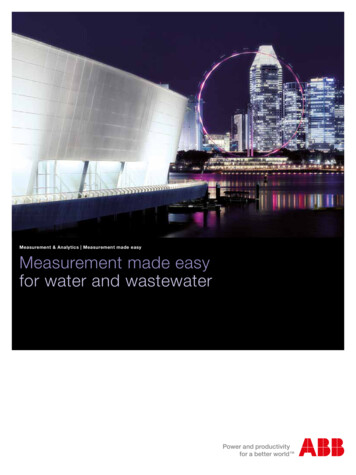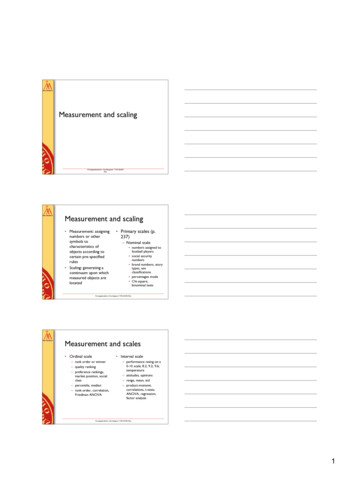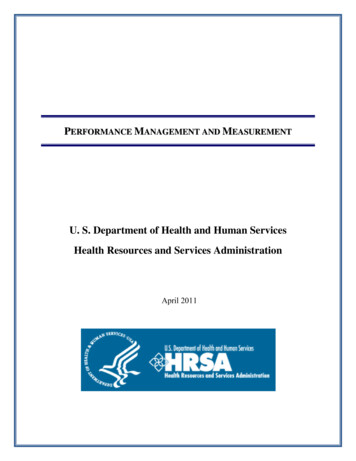
Transcription
PERFORMANCE MANAGEMENT AND MEASUREMENTU. S. Department of Health and Human ServicesHealth Resources and Services AdministrationApril 2011
Performance Management and MeasurementContentsPERFORMANCE MANAGEMENT AND MEASUREMENT . 1Part 1: Overview . 1Introduction . 1What Is Performance Measurement? . 2Why Does an Organization Need to Measure Performance? . 2Types of Performance Measures . 3Performance Management . 3Part 2: Performance Management Process [bookmark]. 5Step 1: Evaluate Organizational Priorities . 7Step 2: Choose Performance Measures. 8Step 3: Determine a Baseline . 9Step 4: Evaluate Performance . 11Step 5: Develop a Plan and Make Changes to Improve Performance . 13Step 6: Monitor Performance Over Time . 14Part 3: Case Story . 14Part 4: References . 14Part 5: Additional Resources . 15June 26, 2012i
Performance Management and MeasurementPERFORMANCE MANAGEMENT AND MEASUREMENTThe purpose of this module is to introduce the fundamental concepts of performancemanagement and assist an organization to develop a practical strategy for achieving its qualityimprovement (QI) goals. This module highlights the use of evidence-based performancemeasures to set QI goals and evaluate an organization’s progress in meeting them.Part 1: OverviewIntroductionSince accountability for performance has become increasingly critical in health care, it isnecessary for an organization to understand the key drivers behind its performance anddemonstrate the results of its work. Performance measurement has many interrelationships withquality improvement (QI), and focus on the use of the data is one of the four key principles ofQI discussed in the Quality Improvement module. Data used for measuring performanceprovides evidence of how well an organization’s system is working currently and what happenswhen changes are applied. Performance measurement data and QI also support and maximizethe usefulness of QI tools. Three important concepts are defined as foundational to a QI datainfrastructure: Performance measures are designed to measure systems of care and are derived fromclinical or practice guidelines. Data that is defined into specific measurable elementsprovides an organization with a meter to measure the quality of its care. Performance measurement is a process by which an organization monitors importantaspects of its programs, systems, and processes. In this context, performancemeasurement includes the operational processes used to collect data necessary for theperformance measures. Performance management is a forward-looking process used to set goals and regularlycheck progress toward achieving those goals. In practice, an organization sets goals,looks at the actual data for its performance measures, and acts on results to improve theperformance toward its goals.Performance measures should be distinguished from clinical guidelines. Clinicalor Practice guidelines are systemically-developed statements to assist practitionersand patients in making decisions about appropriate health care for specificclinical circumstances. Attributes of good guidelines include validity, reliability,reproducibility, clinical applicability, clarity, multidisciplinary process, review ofevidence and documentation. (1) Performance measures provide an indication ofan organization's performance in relation to a specified process or outcome.Practice guidelines that outline the expectations of care around a specific issue ordisease state are created by a group of subject matter or clinical experts. Becauseperformance measures and standards of care each serve a different purpose, theyare not always identical.June 26, 20121
Performance Management and MeasurementThis module describes in detail why performance measurement is important and provides a stepby-step guide for the performance management process.What Is Performance Measurement?Performance measurement is a process by which an organization monitors important aspects ofits programs, systems, and care processes. Data is collected to reflect how its processes areworking, and that information is used to drive an organization’s decisions over time. Typically,performance is measured and compared to organizational goals and objectives. Results ofperformance measurement provide information on how an organization’s current programs areworking and how its resources can be allocated to optimize the programs’ efficiencies andeffectiveness.Performance measurement is well established throughout health care in the core areas of finance,operations, and clinical care services. For example: Finance—an organization often measures the efficiency of its accounts receivables(AR); i.e., timely collection of payment for services rendered Operations—an organization tracks the length of time it takes for a patient to receive anappointment in the practice, or measures patient satisfaction with the care received Clinical Care—an organization measures how often care is delivered in accordance withevidence-based guidelines, or how effective that care is in improving patient outcomesThere are other examples of performance measurement in health care organizations today. Asinformation technology is widely integrated into health care settings, support for performancemeasurement will also expand throughout the organization.Why Does an Organization Need to Measure Performance?There are a number of reasons why an organization may choose to measure its performance.Performance measurement provides a reliable process to determine if an organization’s currentsystem is working well. Also in today’s economy, there is a demand for transparency andincreasing scrutiny of an organization’s business practices. These reasons promote anorganization’s use of process and outcome data as a means to demonstrate its performance.There are other typical circumstances of why an organization may choose to measure itsperformance, such as: Distinguish what appears to be happening from what is really happening Establish a baseline; i.e., measure before improvements are made Make decisions based on solid evidence Demonstrate that changes lead to improvements Allow performance comparisons across sites Monitor process changes to ensure improvements are sustained over time Recognize improved performance2
Performance Management and MeasurementThere are additional motives for a health care organization to measure its performance: Government-accrediting organizations and funding sources rely on performancemeasurement to prove resources are used effectively and efficiently Clinicians use performance measurement to quantify the effectiveness of evidence-basedcare provided by their care delivery systems Organizational leaders use performance measurement to monitor and improvemanagement, clinical care, and support services Fund raising is increasingly tied to documented performanceTypes of Performance MeasuresIt is useful to categorize performance measures to better understand what systems or processesare measured. An organization may combine different types of measures to provide a completepicture of its underlying systems. There are four types of performance measures: Process measure quantifies a health care service provided to, on behalf of, or by apatient, that is based on scientific evidence of efficacy or effectiveness. (2) It quantifies aspecific system; e.g., to get a test done or a service performed. Outcome measure quantifies a patient’s health status resulting from health care. (2) Inthe clinical area, it often measures a patient outcome so it can be compared to a carestandard, such as, a patient’s test value. Balancing measure ensures that changes to improve one part of the system are notcausing new problems in other parts of the system. (3) It examines another part of thesystem to ensure that improvements in one area have no unexpected consequences inanother. Structure of care measure quantifies a feature of a health care organization (orclinician) relevant to its capacity to provide health care. (2)Performance ManagementPerformance management is a process for setting goals and regularly checking progress towardachieving those goals. It includes activities that ensure organizational goals are consistently metin an effective and efficient manner. The overall goal of performance management is to ensurethat an organization and its subsystems (processes, departments, teams, etc.), are optimallyworking together to achieve the results desired by the organization. Performance managementhas a wide variety of applications, such as, staff performance, business performance, or in healthcare, health outcome performance measures.Because performance management strives to align all the subsystems to achieve results, the focusof performance management should also affect the management of an organization’sperformance overall. Figure 1.1 provides an example of a performance measure (cycle time),the process that the organization is measuring, and the benefit the organization might gain inevaluating its performance. While the example is reflective of the patient flow process, anorganization often achieves the same benefit when evaluating its staff, business performance, andtargets for clinical outcomes.3
Performance Management and MeasurementFigure 1.1: Examples of Performance and Associated Process Measurements to Monitor and AnalyzeAn organization can achieve the overall goal of effective performance management bycontinuously engaging in the following activities: Identifying and prioritizing desired results Establishing means to measure progress toward those results Setting standards for assessing how well results are achieved Tracking and measuring progress toward results Exchanging ongoing feedback among those individuals working to achieve results Periodically reviewing progress Reinforcing activities that achieve results Intervening to improve progress where neededOne way to design a well-balanced performance management system is to focus on four strategicperspectives derived from the Balanced Scorecard model as shown in Figure 1.2. (4) TheBalanced Scorecard is a performance management tool to measure whether smaller-scaleoperational activities are aligned with larger-scale objectives in terms of vision and strategy. Theexample depicted below shows that focusing on financial outcomes plus the operational aspectsof a program or organization, the Balanced Scorecard helps provide a more comprehensive view,which in turn helps an organization act in its best long-term interests. For more information onBalanced Scorecards, access the Quality Improvement module.4
Performance Management and MeasurementAdapted from Kaplan & NortonFigure 1.2: Balanced ScorecardIMPORTANT NOTE: The basic steps for managing an organization’s performance are thesame for any performance measure targeted for improvement. In keeping with the focus ofthis toolkit on HRSA Clinical Core Measures, the remainder of this module concentrates onperformance management within clinical areas. Clinical examples are provided to illustratethese basic concepts.Part 2: Performance Management ProcessSuccessful performance management relies on understanding the foundational conceptsthat are covered in other modules of this toolkit. It is assumed that readers have an overallunderstanding of quality principles, understand the basics of performance measurement,and are ready to embrace a quality improvement project within their organization.Performance management concepts presented here allow an organization to systematicallymanage the performance data required to support QI projects. Links to key concepts areembedded so that readers new to this content can link to the basic concepts before movingforward.Performance management encompasses a series of steps with some embedded decision points.This part of the module illustrates each step in the performance management process based onthe practices of effective health care organizations. The schematic in Figure 2.1: Process Map5
Performance Management and Measurementof Performance Management Pathway provides an overview of the critical steps and flow,which is followed by a detailed description for each step.Figure 2.1: Process Map of Performance Management Pathway6
Performance Management and MeasurementStep 1: Evaluate Organizational PrioritiesThe first step ensures that the resources dedicated to manage and measure performance aredirected to the organizational strategic goals and mission. The primary reason to measure andmanage performance is to drive quality improvement. The dialogue about an organization’spriorities should include the community’s assessment, the organization’s strategic plan, qualitymanagement plan, and similar strategic documents. Often, an organization reflects on what isnot working well to determine its focus. In some cases, improvement priorities are determinedby grant expectations, outside funders, or accrediting agencies. One key component of this firststep is that the discussion should focus forward; that is: What kind of care does the organization want to provide? What community needs should be addressed by the organization? How can the organization most efficiently use resources to meet the need?An organization also needs to consider critical opportunities for improvement from the patient’sperspective. For an in depth overview of some critical areas from the patient’s perspective, referto the Committee on Quality of Health Care in America, Institute of Medicine; Crossing theQuality Chasm: A New Health System for the 21st Century. This report highlights six focusareas of care that patients consider important: Safety—avoiding injuries to patients from the care that is intended to help them Effective—providing services based on scientific knowledge to all who can benefit andrefrain from providing services to those not likely to benefit (avoiding underuse andoveruse) Patient-centered—providing care that is respectful of and responsive to individual patientpreferences, needs, and values and ensuring that patient values guide all clinical decisions Timely—reducing waits and sometimes harmful delays for both those who receive andthose who give care Efficient—avoiding waste, in particular, waste of equipment, supplies, ideas, and energy Equitable—providing care that does not vary in quality because of personalcharacteristics, such as gender, ethnicity, geographic location, and socioeconomic status(5)The time that an organization’s leaders spend discussing priorities is time well spent. Thesestrategic discussions improve buy-in from key leaders within the organization and encouragereflection from multiple perspectives. An advanced discussion on the importance of evaluatingorganizational priorities can be found in the Readiness Assessment and Developing ProjectAims module.7
Performance Management and MeasurementStep 2: Choose Performance MeasuresAfter an organization discusses what is important to measure, the next step is to choose specificperformance measures. Understanding that the delivery of care is a number of systems andprocesses, performance measures serve as indicators for the effectiveness of those systems andprocesses. Consider the following in selecting performance measures: Measure what is important based on the evaluation of an organization’s community,population, and priorities as determined in Step 1 Measure what is required to meet funding or contractual expectationsThese first two considerations often overlap. Agencies supporting or funding a health careorganization may require specific performance measures. If an organization is currently fundedby HRSA, it should review the program’s Web site or guidelines for specific requirements whenchoosing measures of quality performance. Guidelines and program-specific information can befound at the following links:BPHC MCHB HABBHPrORHP OHITQORONote: If an organization is currently funded by HRSA, some performance measures, including clinical qualitymeasures, may be among those reported to HRSA. An organization should consult its project officer and/or program’sWeb site and links to Bureau and Office required guidelines and measures for more information:BPHCMCHBHABHSBBHPrORHPOHITQOROGeneral information on HRSA grants including searchable guidelines are available and accessible at theHRSA Grants Web site. Include staff in the measure selection process since staff will be involved in the actualimplementation of measurement and improvement activities. Buy-in from staffsignificantly facilitates these steps.Use existing measures, if possible. Clinical performance measures are derived fromevidence-based clinical guidelines. Measurement allows an evaluation of an importantoutcome of care for a designated population of patients, and it is a proxy to understandthe effectiveness of the underlying systems of care. Just as there are evidence-based careguidelines for many conditions, there also are established measures that indicate howeffectively guidelines are translated to practice. National organizations carefullyconsidered these measures, and it is advisable to adopt an established measure. Examplesof general sources for clinical measures include:o Healthcare Effectiveness Data and Information Set (HEDIS)o AHRQ Clearinghouse of Clinical Measureso National Quality Forumo National Initiative for Children’s Healthcare QualityIf an organization creates its own measure, consider the characteristics of goodperformance measures and the IOM framework, Envisioning the National HealthcareQuality Report:8
Performance Management and Measurement o Relevance: Does the performance measure relate to a frequently-occurringcondition or has a great impact on patients at an organization’s facility?o Measurability: Can the performance measure realistically and efficiently bequantified given the facility’s finite resources?o Accuracy: Is the performance measure based on accepted guidelines or developedthrough formal group decision-making methods?o Feasibility: Can the performance rate associated with the performance measurerealistically be improved given the limitations of the clinical services and patientpopulation?Consider using several measures of different types as described above. For example,diabetes care may best be evaluated by including:o Frequency of evidence-based testing (process measure)o Patient blood pressure control (outcome measure)o Patient satisfaction as diabetes care delivery evolves (balancing measure)o Calculation of co-pays regarding clinical monitoring of diabetes care (structuralmeasure)A hypothetical case story is provided in sections throughout this module. The story depicts theeffort of one (fictional) organization named Harper Clinic to choose a strategy for measuringperformance improvement. The full case story can be accessed by clicking here.The ProblemHarper Clinic is a Federally Qualified Health Center (FQHC) that was established as a new start last year. The constructionproved more challenging than anticipated but the clinic leadership was ready to embark on tackling some of the issues uncoveredduring the Community Needs Assessment. In addition to providing general services for the community, it wants to focus on thesizeable elderly population. Organization-led focus groups determined that geriatric patients have transportation difficulties,which led to challenges in attending clinic appointments and refilling prescriptions.The organization planned a systematic approach to improve care delivery and outcomes for the geriatric population. “Improvegeriatric services” is included as a goal in the strategic plan and the quality improvement plan stated a focus on clinical outcomesfor patients over age 65 during the next year. Based on research and feedback from the focus groups, the QI team proposedchanges it wants to make but agreed that measurement should be an important part of any improvement. The QI team leadexplored the HRSA Web site and suggested possible performancemetrics.Based on organizational goals and the information from focusgroup members, Harper Clinic chose to research two measures – Older Adult Immunizations and Hypertension AdequateControl. The team reasoned that immunization measures would allow it to experiment with different strategies to deliver careand consider challenges with transportation and access. It selected the Hypertension measure since cardiovascular disease wasprevalent in the community and required medication adherence for successful performance. The team looked at the availabledata in a way that was most helpful. It looked at the Older Adult Immunization measures for those 65 and over and calculatedthe hypertension measure considering the entire patient population with hypertension.Step 3: Determine a BaselineOnce performance measures are chosen, an organization collects the baseline data for eachmeasure. Baseline data is a snapshot of the performance of a process or outcome that is9
Performance Management and Measurementconsidered normal, average, or typical over a period of time and reflects existing care systems.Determining the baseline involves calculating the measure. As an organization assesses where itis before embarking on a QI program, it often finds its data reflects a lower-than-desiredperformance. This should not cause alarm but rather provide the opportunity to focus QI effortsto improve performance.Established performance measures include details about the numerator and denominator tocalculate the measure. There is guidance for pertinent CPT or ICD-9 codes and patient exclusioncriteria. Specifics about calculating a baseline for the quality measures are included in eachclinical module. First Trimester Care AccessPercentage of pregnant women beginning prenatal care in the first trimester ofpregnancy HIV Screening for Pregnant WomenPercentage of pregnant women who were screened for HIV infection during the first orsecond prenatal care visit Breast Cancer ScreeningPercentage of women 40 to 69 years of age who had a mammogram Cervical Cancer ScreeningPercentage of women 21 to 64 years of age who received one or more Pap tests Colorectal Cancer ScreeningPercentage of adults 50 to 80 years of age who had appropriate screening for colorectalcancer Diabetes - HbA1c {Poor Control}Percentage of adult patients 18 to 75 years of age with type 1 or 2 diabetes with mostrecent hemoglobin A1c (HbA1c) greater than 9 percent (poor control) Hypertension ControlPercentage of adult patients, 18 to 85 years of age, with diagnosed hypertension (HTN)whose blood pressure (BP) was adequately controlled ( 140/90) during themeasurement yearTip: It is wise to be able to explain, teach, and re-evaluate the step-by-stepprocess to calculate the measure for future iterations, and replicate it reliablyin the future. Specifically, it is important to record the following for eachmeasure: Data source Collection method Frequency of data collection Standardized time to collect data as applicable Identify staff responsible for measurement and other aspects of themeasurement process to create a detailed record.Case Story continued.10
Performance Management and MeasurementThe ApproachThe clinic used its electronic health record and practice management system to calculate a baseline for each measure. The teamfound that, for patients 65 and older, the influenza vaccine rate for the last season was 52 percent; the pneumococcal vaccine ratewas 44 percent, and the hypertension in control rate for patients between 65 and 85 years of age was 34 percent. It thencompared the data with available benchmarks. For vaccine rates, the National Immunization Survey of 2007 indicated rates forinfluenza vaccine were 69 percent while pneumococcal vaccine rates were 66 percent. NCQA State of Health Care Quality(ncqa.org) stated that blood pressure was controlled in 58 percent of Medicare recipients, closely corresponding to the targetpopulation.Step 4: Evaluate PerformanceAs Figure 2.2: Evaluate Performance Map shows, once the baseline calculation is complete,an organization decides if performance is satisfactory or improvements are needed. To providecontext for evaluating baseline data, an organization may choose to compare and benchmark itsdata against other health care organizations. Benchmarking is a process that comparesorganizational performance with health care industry best practices, which may include datafrom local, regional, or national sources. Benchmarking brings objectivity to the analysis ofperformance and identifies the strengths and weaknesses of a health care organization.Figure 2.2: Evaluate Performance Map11
Performance Management and MeasurementIf an organization is satisfied with its current level of performance, then it may: Acknowledge and celebrate its success! Put a system in place to monitor performance periodically. The measure was selectedbecause it is important to the organization; check performance periodically to ensure thatthe underlying systems involved in performance continue to function satisfactorily. Consider another performance measure.If an organization’s performance is less than desired, then it may establish an aim forimprovement. If new to writing aim statements, read Developing Aim Statements in theReadiness Assessment and Developing Project Aims module. Since there is more than oneway to establish goals for a performance measure, an organization typically considers thefollowing three factors to inform that decision:Note to HRSA Reviewers: This box may be depicted to link with graphic above from text box associated with the "NO" in the graphicFactor 1: Are there aims already established that should be used? Program requirements orthose required by funding agencies may include performance thresholds. It is prudent to choosethe aim that requires the highest level of performance if an organization has overlappingrequirements with established aims. An organization currently funded by HRSA shouldreview the program’s Web site or program guidance for program-specific requirements.Guidelines and program-specific information can be found at the following links:BPHCMCHBHABHSBBCRSBHPrORHPOHITQGeneral information on HRSA grants, including searchable guidelines, is available andaccessible at the HRSA Grants Web site.Factor 2: How does the system currently perform? The baseline reflects the current status quo.The larger the desired change, the more the underlying systems have to change. Someorganizations choose to set aims that indicate a percentage of improvement expected over theirbaseline, while others choose aims that reflect their desired performance, regardless of theirbaseline performance.Factor 3: Does the aim statement meet the essential criteria of SMART? Specific Measurable Acceptable Realistic to achieve Time-bound with a deadlineCase Story continued.Performance EvaluationThe clinic staff decided there was room for improvement in all three measures. It considered the current performance, whatothers were able to achieve, and what improvement could be accomplished during the next year. The staff wrote the followingaim statement:Harper Clinic is dedicated to the improved health of elder residents in our community. To that end, we will implement theCare Model to improve care and achieve the following aims by March 30, 2009:12
Performance Management and Measurement1. Percentage of patients 65 years and older who have received influenza vaccine during flu season, September 1, 2008through February 28, 2009 will be 65 percent.2. Percentage of patients 65 years of age who have ever received a pneumococcal vaccine will be 65percent.3. Percentage of patients 18-85 years of age with a diagnosis of hypertension (HTN) and whose blood pressure (BP)was adequately controlled ( 140/90) during the measurement year will be 50 percent.Senior leadership approved the goals and allocated resources to support the efforts. Since immunization systems are similar,regardless of antigen administered, improvement efforts could be managed in the same way. Two quality improvement teamswere created to work on two QI projects:1. Older Adult Immunization rate focusing on both influenza and pneumococcal vaccine rates2. Older Adult Hypertension controlStep 5: Develop a Plan and Make Changes to Improve PerformanceIf an organization previously worked to improve quality, it is likely there is an establishedapproach for improving quality already. A QI plan is a strategy for identifying andimplement
Performance management is a process for setting goals and regularly checking progress toward achieving those goals. It includes activities that ensure organizational goals are consistently met in an effective and efficient manner. The overall goa

